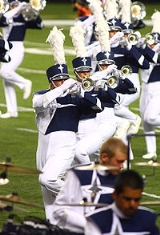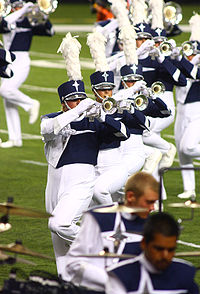
Blue Stars Drum and Bugle Corps
Encyclopedia

Drum and bugle corps (modern)
A drum and bugle corps, also known as a drum corps, is a musical marching unit consisting of brass instruments, percussion instruments, and color guard. Typically operating as independent non-profit organizations, drum corps perform in competitions, parades, festivals, and other civic functions...
based in La Crosse, Wisconsin
La Crosse, Wisconsin
La Crosse is a city in and the county seat of La Crosse County, Wisconsin, United States. The city lies alongside the Mississippi River.The 2011 Census Bureau estimates the city had a population of 52,485...
and founded in 1964. The corps was one of the original members of the "Combine" (along with the Troopers
Troopers Drum and Bugle Corps
The Troopers are a World Class drum and bugle corps that competes in Drum Corps International. They are a founding member of Drum Corps International, and their operations are centered in Casper, Wyoming. They are the only active drum and bugle corps in Wyoming...
, the Cavaliers, the Scouts
Madison Scouts Drum and Bugle Corps
The Madison Scouts Drum and Bugle Corps is a summer youth drum corps based in Madison, Wisconsin that competes in the Drum Corps International circuit. Founded in 1938, it is the third oldest corps in the DCI circuit, after the Cadets, and the Racine Scouts, founded in 1934 and 1927, respectively....
, and the Vanguard
Santa Clara Vanguard Drum and Bugle Corps
Santa Clara Vanguard Drum and Bugle Corps is a World Class drum and bugle corps based in Santa Clara, California and founded in 1967, and is a member corps of Drum Corps International...
), which was the precursor to Drum Corps International
Drum Corps International
Drum Corps International , formed in 1972, is the non-profit governing body operating the North American drum and bugle corps circuit for junior corps, whose members are between the ages of 14 and 21. It is the counterpart of Drum Corps Associates which governs senior or all-age drum corps...
.
The Blue Stars were one of the most successful DCI open class corps in the 1970s, placing second at the inaugural DCI Championships in 1972, and appearing as a DCI finalist every year from 1972 through 1979. The corps was also the Veterans of Foreign Wars National Champion in 1977. After reorganization in the early 1980s, the corps became one of the most consistent corps in Division II/III (now Open Class) history, never placing lower than 5th in its division from 1987 to 2005, and winning Division III titles in 1989, 1993, 2001, and 2003. The 2006 season marked the Blue Stars' return to Division I (now World Class) competition.
2003-2005
In 2004, following an undefeated season and championship in Division III the previous year, the corps saw growth in membership that it had not seen in years. In 2004 and 2005, the corps began a plan to expand to the then-maximum drum corps size of 135 members, and return to Division 1 competition. In 2004, the corps placed 5th in Division II competition, and then achieved 3rd in 2005.2006-2007
In 2006, the Blue Stars returned to Division I competition for the first time since 1982. Presenting a program entitled "The Gift of Freedom," their comeback was well-received at the quarterfinals and semifinals in Madison, WisconsinMadison, Wisconsin
Madison is the capital of the U.S. state of Wisconsin and the county seat of Dane County. It is also home to the University of Wisconsin–Madison....
. The 30,000 member audience was said to have cheered so loud that the corps members could not hear their own playing. The corps returned to DCI Division I (now World Class) competition, placing 14th place in the semi-finals.
In 2007, the corps debuted a more contemporary uniform design. Gone were the cross-straps and buckle used for the majority of its existence, though the trademark helmet design was retained. The new uniform featured a split color on the pants, where the right half of the right leg was white, and the rest of the pants were blue. The jacket featured a silver north-star symbol, and the helmet donned a white plume. The corps has a solid white appearance when marching toward the side-2 endzone, and solid blue when marching toward side-1. This color contrast was incorporated into the "Power & Grace" program.
The corps continued its growth in 2007, placing 14th at DCI semifinals at the Rose Bowl
Rose Bowl (stadium)
The Rose Bowl is an outdoor athletic stadium in Pasadena, California, U.S., in Los Angeles County. The stadium is the site of the annual college football bowl game, the Rose Bowl, held on New Year's Day. In 1982, it became the home field of the UCLA Bruins college football team of the Pac-12...
in Pasadena, California
Pasadena, California
Pasadena is a city in Los Angeles County, California, United States. Although famous for hosting the annual Rose Bowl football game and Tournament of Roses Parade, Pasadena is the home to many scientific and cultural institutions, including the California Institute of Technology , the Jet...
, with the drumline achieving 12th and the hornline placing 11th musically.
2008, 2009 Seasons - Return to Finals
2008 continued the growth and improvement of the corps that was initiated several years earlier. The new Blue Stars uniform featured a return of the blue and white split jackets. However, this year the pants were completely white. Halfway through the season, going into the Atlanta regional competition, the corps changed from their helmets to new shakos. The shakos are navy blue with a silver north star in the center with white plumes. The corps made this change after 30 years of wearing helmets. This change brought mixed feelings among the corps alumni. Starting in the 2008 season, the drum major brings a helmet and red plume onto the podium for the finals night performance, which the drum major sets their shako next to.In 2008, the Blue Stars presented a program entitled “Le Tour: Every Second Counts”, with visuals intended to exemplify the passion, intensity, endurance, and teamwork required to compete in the Tour de France
Tour de France
The Tour de France is an annual bicycle race held in France and nearby countries. First staged in 1903, the race covers more than and lasts three weeks. As the best known and most prestigious of cycling's three "Grand Tours", the Tour de France attracts riders and teams from around the world. The...
cycling event. The musical repertoire featured arrangements based on familiar melodies by the French composers Fauré
Faure
Faure or Fauré is a French family name and may refer to:People:* Edgar Faure, French politician* Élie Faure, French art historian and essayist* Émile Alphonse Faure, lead battery pioneer* Cédric Fauré, French football striker...
, Satie, Debussy, Saint-Saëns, Widor, and Ravel.
Le Tour proved to be a highly competitive program. The Blue Stars placed 9th at the 2008 World Class quarterfinals in Bloomington. Indiana
Indiana
Indiana is a US state, admitted to the United States as the 19th on December 11, 1816. It is located in the Midwestern United States and Great Lakes Region. With 6,483,802 residents, the state is ranked 15th in population and 16th in population density. Indiana is ranked 38th in land area and is...
, in close contention with three other corps. Only .8 of a point separated the Blue Knights in 8th place and the Glassmen in 11th. All four moved to the semifinals, where the Blue Stars earned 8th place with a score of 90.575. This was the highest score in Blue Stars Division 1/World Class history. The Blue Stars finished their season at 8th place with a score of 90.425. This was the first time the Blue Stars had competed in the Division 1/World Class finals since the 1979 season.
After the return to finals in 2008, the corps carried its momentum into 2009 with their program, "The Factory". The corps entered the season from the beginning with a competitive show that many described as a show designed with finals in mind. Visually and musically the corps competed for the hotly contested 7-9 spots, trading blows with the Boston Crusaders and the defending world champions, Phantom Regiment. In quarterfinals, the Blue Stars received 9th place with a score of 89.950. A mere .75 separated the three corps in the 7-9 positions. Semifinals night arrived, and the corps placed 9th for the second night in a row with a score of 90.4, only .25 behind the 8th place corps, Phantom Regiment. After an inspired finals performance, the corps was able to jump into 8th place to overtake Phantom Regiment. The corps scored a 90.050.

